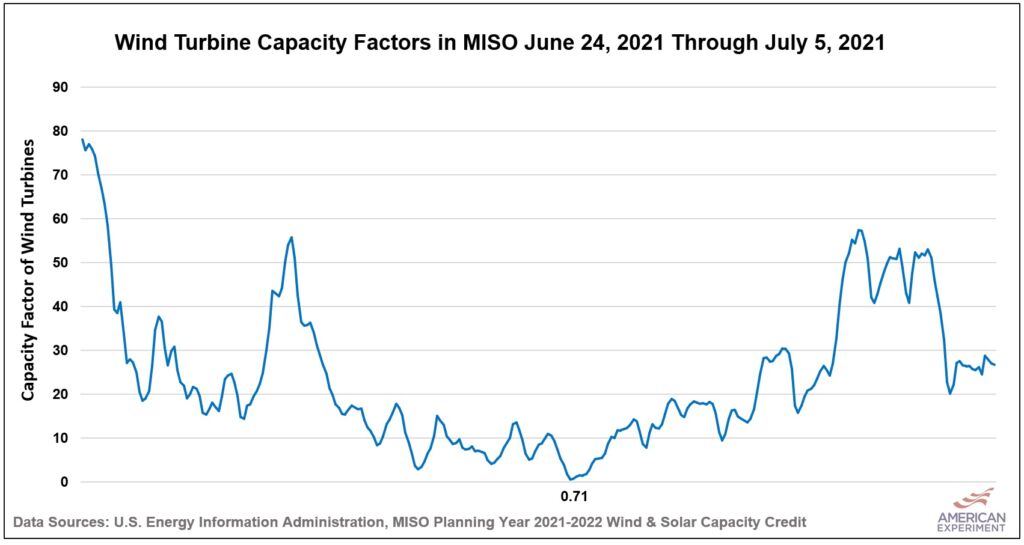The Star Tribune finally says the “B-word”
The Star Tribune has finally said the “b-word:” blackouts.
Several of our readers reached out to me over the weekend to share this article from the Star Tribune, entitled “Midwest, including Minnesota, at greater risk for rolling blackouts this summer.”
It is the first time, to my knowledge, that the Strib has acknowledged that the blackouts that have plagued California, Texas, and states in the Southwest Power Pool may be coming to Minnesota, and those blackouts are due to the fact that we are closing down reliable, clean, beautiful coal plants, and becoming overly reliant upon unreliable wind and solar generators.

The article reads:
As the energy feeding the regional electricity grid changes from coal to more renewable, a big spike in demand could cause a power shortfall, the grid regulator says.
Electricity demand on the Midwest’s grid is expected to be strong this summer, with hot weather and a growing economy sucking plenty of juice.
At the same time, electricity supplies are tightening. The upshot: The risk of rolling blackouts is elevated.
Underlying this vexing outlook is the grid’s transition from fossil-fuel power to renewable energy. Power lost from retiring coal plants is exceeding the supply gained by new wind and solar farms.
“This is a harbinger of things to come,” said David Sapper, director of intelligence for MISO markets at Philadelphia-based Customized Energy Solutions, which analyzes regional U.S. power grids. “These type of conditions could prevail for many years.”
The Midcontinent Independent System Operator (MISO) — which operates the grid in Minnesota, all or parts of 14 other states and Manitoba, Canada — estimates that about 33 gigawatts of coal-power capacity will be retired by 2041.
Mitch Rolling and I have been warning about this eventuality for years. For example, our formal comments to the Public Utilities Commission on Xcel Energy’s Integrated Resource Plan highlighted that the company was shutting down too many reliable power plants and relying too heavily on wind and solar.
As a result, Xcel is planning to fail by becoming too reliant upon intermittent wind and solar and “load management,” which is a fancy term for brownouts.

Last year, American Experiment ran billboards demanding reliable energy, which were ridiculed by wind and solar advocates as “disinformation.” We knew these criticisms were wrong, and now the Strib’s readers are getting their first taste of energy reality.

The Strib article continues:
On paper, lost coal-fired capacity through 2041 will be more than made up by new renewables in MISO: 39 gigawatts of solar power and 21 gigawatts of wind. (A gigawatt is 1 billion watts.)
But renewable power doesn’t have the constancy of fossil fuel or nuclear plants. So, power generating capacity gained by renewables isn’t a one-for-one replacement for what’s lost from coal plants.
“It’s a new era,” said Scott Wright, MISO’s executive director for resource planning.
While the generation mix is changing, severe weather is increasingly toying with the delicate electricity supply-and-demand balance in MISO and other regional U.S. electric grids.
MISO’s summer power demand outlook is based partly on forecasts for higher than normal temperatures, elevated storm risk and an active hurricane season in the grid’s southern region.
“Part of this is a climate story, and we don’t want to lose sight of that,” said Allen Gleckner, lead director for clean electricity at research and advocacy group Fresh Energy in St. Paul. “This isn’t a simple story of coal plants retiring.”
Wind and solar are far less reliable than coal plants, which is why the grid operator assumes they will only be available 15 percent of the time for wind, and 50 percent for solar. Reliable coal, natural gas, and nuclear plants are usually assumed to have availability at 90 percent of their installed capacity.
This means that it would take 6 MW of wind capacity to theoretically replace the production of 1 MW of a coal plant, but this is no guarantee that wind will actually produce at these levels. Last June, wind production bottomed out at less than 1 percent of its potential output, according to federal data.

This is where I disagree with Allen Gleckner of Fresh Energy. It is as simple as the coal plants retiring because their premature closure means there is not enough reliable capacity left on the system to meet electricity demand.
Building more transmission lines for wind and solar won’t help if wind is producing less than 1 percent of its potential output. As my friend Emmet Penney wrote, groups like Fresh Energy are proposing transmission solutions to generation problems.
American Experiment has been sounding the alarm on the coming blackouts for years. The only way out of this problem is to ensure we have enough reliable power plant capacity online to meet peak demand. It is one reason why we have been the most vocal advocates of keeping our existing coal plants open as long as possible and legalizing new nuclear power plants to eventually replace them.